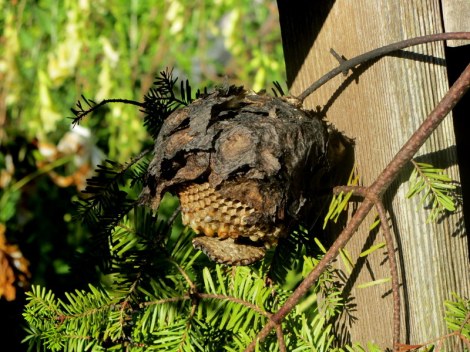My husband had been clearing a few stubby maples away from a wild Nannyberry bush I wanted to encourage when he disturbed a wasp’s nest and was stung, only once, thank goodness. He located the melon-sized nest in a low fir tree only a couple of feet off the ground. The sting made his hand swell immediately but an application of cortisone ointment and Tecnu (which contains the Native American herbal remedy of Great Valley Gumweed, Grindelia robusta) ameliorated the pain and swelling. I identified the wasp as an Aerial Yellowjacket (Dolichovespula arenaria) which can be beneficial as it feeds on aphids and similar garden pests but this nest is in a location where we walk by and the Yellowjackets are aggressive and can sting multiple times. Some people are allergic to the venom. [As a result of the comment from Larry Flynn below, I want to make it clear that Yellowjackets are wasps, entirely different from bees. Bees are in deep trouble due to colony collapse disorder and are crucial to our planet as pollinators.]
I thought little more about it until my husband woke me at 4:30 a.m. to declare he was going out to burn out the nest. He had obviously been brooding about this and had a plan of action. The nest was too low to use a wasp spray and the job needed to be done in the dark. I wanted him to first alert the fire department and put the hospital emergency room on call but he ignored this advice. He went down to the nest, fully covered and gloved, armed with a gasoline soaked torch, fire extinguisher in hand. He returned with the burned out nest. He had put the lit torch directly under the hole and the nest lit up inside, killing the adults. Some of the larvae were still wriggling in the morning and he killed them by crushing the remainder of the nest. I question whether this was necessary but at least the area is safe for grandchildren and potential guests to walk by.

Larry Flynn said,
July 8, 2012 @ 10:32 pm
You can’t be serious? Your hubby stumbles upon a bee hive, the bees protect there hive and he gets stung by one bee! Just one!!!
You state that he was clearing to save a Nannybush, these bee’s reacted to the disturbance of their nest, and that these bee’s are benificial to the enviorment. but you killed all of them all. Why?
If your were a true naturalist, you folks never would have done this knowing all along the issues with the massive lack of bees these days, Great Job, well done, what’s wrong with you!!!
Please drop yor claim to being a Naturalist.
Your poor excuse is that the grandchildren and others walk this area. It wasn’t a issue before hubby invaded the colony.
A good naturalist would explain to the children (and hubby) that there are bee hives inthe area and lets give them their space, instead of burning the bees in there nest
In layman’s terms, if you are a naturalist, may I never be one!
Larry Flynn
LikeLike
naturaliststable said,
July 9, 2012 @ 6:17 am
Larry, I’m sorry if I have offended you. I would never destroy a bees nest or bee hive. These were Yellowjackets, not bees. They are not important pollinators and are not in trouble like bees are. Here is a quote from the USDA website about pollinators http://www.ars.usda.gov/Main/docs.htm?docid=11414 “Yellow Jacket: Yellow jacket wasps (Vespula) are often mistaken for bees. Indeed, some folks call them “meat bees”, but they are in fact social wasps related to hornets and only distantly related to bees. Yellow jackets may on occasion visit flowers (or your water-melon slice) for sugar, but unlike bees, yellow jackets are carnivorous, eating insects, carrion and picnic fare. Hence, they have no brushes or pollen baskets for carrying pollen. They are relatively hairless and all resemble the one pictured here. Their nests are made of paper, not wax, typically built in shallow underground cavities. In only a few instances are they thought to be pollinators. Like honeybees and bumble bees, yellow jackets have a potent sting.”
LikeLike
Carla said,
July 11, 2012 @ 12:20 pm
Wow, did Larry even read the posting that clearly stated these were YELLOWJACKETS? Just …. wow. 😦
Carla
LikeLike
naturaliststable said,
July 11, 2012 @ 5:12 pm
I admire his passion and think it’s a good thing as his comment made it clear that many people DO confuse wasps and bees. I added the sentence in brackets to the post and hope he feels a little better about it.
LikeLike